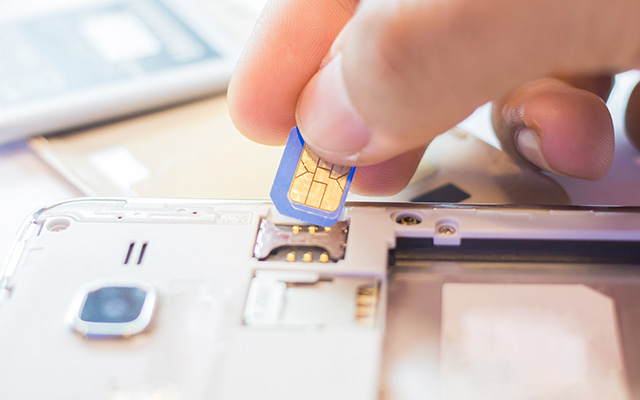What is eUICC?
UICC (Universal Integrated Circuit Card) describes the SIM card which has been used since 1991 in mobile phones and latterly in IoT devices. Embedded UICC (eUICC) refers to a specific type of UICC software that enables a SIM to host multiple profiles. Crucially, eUICC also facilitates over the air (OTA) provisioning, making it possible to update your IoT applications remotely.
eUICC technology can significantly enhance IoT project scalability and ease of management. Here’s a closer look at how it works.
What is the difference between eUICC and eSIM?
The two acronyms eUICC and eSIM are sometimes used interchangeably. Strictly speaking, however, eUICC refers to the software (and network infrastructure) and eSIM describes the hardware.
eSIM is however widely assumed to mean eUICC.
A SIM (Subscriber Identity Module) is a contact chip containing a device’s authentication credentials, enabling that device to access a cellular network. As with eUICC, the ‘e’ in eSIM stands for ‘embedded’. Instead of the familiar removable card format, an eSIM is a vacuum-sealed chip that is soldered directly to a board within the device. This form factor is known as MFF2 (machine-to-machine form factor).
eUICC refers to a particular type of software standard deployed on a SIM card. Under the traditional UICC standard, a card can usually contain just a single mobile network operator (MNO) profile. This means that if you want to switch operators, you have to physically replace the SIM. With eUICC however, the card can host multiple profiles. You can also add, remove or manage these profiles over the air via a method called remote SIM provisioning (RSP). Network infrastructure and systems are also required to manage eUICCs.
It’s also worth noting that even though it has the word ‘embedded’ in the name, the use of eUICC isn’t confined to soldered MFF2 eSIMs. You can, in fact, get eUICC versions of all the popular SIM form factors (mini, micro and nano). So even if your existing IoT devices cannot accommodate eSIMs, this should not necessarily stop you from tapping into the benefits of eUICC.

How does eUICC work for IoT?

Making an initial connection
Each eUICC-enabled SIM is equipped with an initial (or bootstrap) profile which is loaded during the SIM manufacturing stage. This enables the device to make an initial connection with a network, while also providing a blank slate for a profile – or multiple profiles – to be added if that is required.
In many cases, the initial profile will remain unchanged and serve as insurance against potential commercial, coverage or service-related issues.
Enabling a new profile
For eUICC provisioning and management, the Remote SIM Provisioning (subscription management) platform comprises two core functions. The first is called subscription manager – data preparation (SM-DP), which creates and stores profiles governing your preferred mobile network and subscription settings, and delivers these profiles to your eUICCs. The second is subscription manager – secure routing (SM-SR), which manages the status of your profiles.
During an over-the-air profile change, the SM-DP downloads the new operational profile to the device’s eUICC SIM. The SM-SR tells the eUICC SIM to enable the new profile. The eUICC then confirms a successful profile installation via SMS. The device is then authorised to connect to the alternative mobile network.
Ongoing management
The SM-DP can be used to store new profiles as they are required. Using the SM-SR, you can tell the eUICC to disable, enable, swap or delete profiles to match your business requirements.
The benefits of eUICC
Cost of ownership
As their IoT initiatives expand, it’s common for businesses to have large numbers of IoT devices scattered across various locations. In terms of cost-effectiveness and reliability, your best choice of mobile network operator may vary from region to region. You might also want to swap operators at some point or to upgrade your connectivity method (e.g. from 3G to 4G or 5G).
With eUICC, individual devices can receive customised profiles based on their location and usage needs. Thanks to remote SIM provisioning and the ability to have multiple profiles on a single card, it becomes much easier and quicker to swap an existing data plan for a newer, more cost-effective one. You can also disable that new profile and swap it back again if circumstances change.
Scalability and ease of deployment
Let’s say you are ready to launch a new IoT device across a range of markets. With the traditional SIM model, you would need to equip the right card in each device, depending on which location it will be deployed. It’s a potentially time-consuming process, as well as being prone to error.With eUICC however, each device gets the same card, and the relevant profile can be added or updated remotely, as needed. It means you can roll out and scale up your project quicker and with less hassle.

Overcoming SIM management challenges

Especially in manufacturing and industrial use cases, devices may be deployed in difficult-to-access settings or linked to critical ‘always-on’ processes. A physical SIM swap means unwelcome disruption and cost. eUICC allows you to change or update profiles remotely, helping you maintain business continuity.
In other cases (e.g. transport and logistics), devices are constantly on the move. With eUICC, you can preload those devices with multiple profiles and enable them to switch seamlessly from one profile to another as they move from region to region. It may be that some vehicles are diverted to a completely new region, in which case you have the option of uploading a fresh profile over the way. In this way, eUICC becomes a useful tool in managing the cost and connectivity issues that can arise as a result of supply chain disruption.
eUICC can perform a key role in simplifying and automating your connectivity management, while also making it easier to change or update your data plans. For more information on the best way to manage connected IoT assets, take a look at the Wireless Logic SIMPro platform.
To learn more about eUICC, find our whitepaper here.
Find out more
For an expert assessment of your connectivity needs and to discover the best fit for your connectivity options, speak to Wireless Logic today.
Learn more about eUICC/eSIM technology here.